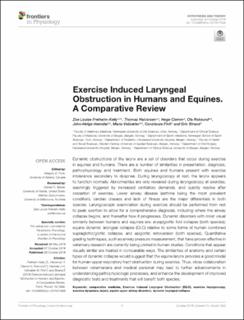| dc.contributor.author | Fretheim-Kelly, Zoe Louise | |
| dc.contributor.author | Halvorsen, Thomas | |
| dc.contributor.author | Clemm, Hege Synnøve Havstad | |
| dc.contributor.author | Roksund, Ola Drange | |
| dc.contributor.author | Heimdal, John-Helge | |
| dc.contributor.author | Vollsæter, Maria | |
| dc.contributor.author | Fintl, Constanze | |
| dc.contributor.author | Strand, Eric | |
| dc.date.accessioned | 2020-05-11T11:49:13Z | |
| dc.date.available | 2020-05-11T11:49:13Z | |
| dc.date.created | 2019-10-22T19:34:25Z | |
| dc.date.issued | 2019 | |
| dc.identifier.citation | Frontiers in Physiology. 2019, 10, 1333 | en_US |
| dc.identifier.issn | 1664-042X | |
| dc.identifier.uri | https://hdl.handle.net/11250/2653896 | |
| dc.description | This is an open-access article distributed under the terms of the Creative Commons Attribution License (CC BY). The use, distribution or reproduction in other forums is permitted, provided the original author(s) and the copyright owner(s) are credited and that the original publication in this journal is cited, in accordance with accepted academic practice. No use, distribution or
reproduction is permitted which does not comply with these terms. | en_US |
| dc.description.abstract | Dynamic obstructions of the larynx are a set of disorders that occur during exercise in equines and humans. There are a number of similarities in presentation, diagnosis, pathophysiology and treatment. Both equines and humans present with exercise intolerance secondary to dyspnea. During laryngoscopy at rest, the larynx appears to function normally. Abnormalities are only revealed during laryngoscopy at exercise, seemingly triggered by increased ventilatory demands, and quickly resolve after cessation of exercise. Lower airway disease (asthma being the most prevalent condition), cardiac disease and lack of fitness are the major differentials in both species. Laryngoscopic examination during exercise should be performed from rest to peak exertion to allow for a comprehensive diagnosis, including where the airway collapse begins, and thereafter how it progresses. Dynamic disorders with most visual similarity between humans and equines are: aryepiglottic fold collapse (both species); equine dynamic laryngeal collapse (DLC) relative to some forms of human combined supraglottic/glottic collapse; and epiglottic retroversion (both species). Quantitative grading techniques, such as airway pressure measurement, that have proven effective in veterinary research are currently being piloted in human studies. Conditions that appear visually similar are treated in comparable ways. The similarities of anatomy and certain types of dynamic collapse would suggest that the equine larynx provides a good model for human upper respiratory tract obstruction during exercise. Thus, close collaboration between veterinarians and medical personal may lead to further advancements in understanding pathophysiologic processes, and enhance the development of improved diagnostic tests and treatments that will benefit both species. | en_US |
| dc.language.iso | eng | en_US |
| dc.subject | comparative medicine | en_US |
| dc.subject | Exercise Induced Laryngeal Obstruction (EILO) | en_US |
| dc.subject | exercise laryngoscopy | en_US |
| dc.subject | exercise dyspnoea | en_US |
| dc.subject | larynx | en_US |
| dc.subject | equine upper airway disorders | en_US |
| dc.subject | dynamic laryngeal collapse | en_US |
| dc.title | Exercise induced laryngeal obstructions in humans and equines: A comparative review | en_US |
| dc.type | Peer reviewed | en_US |
| dc.type | Journal article | en_US |
| dc.description.version | publishedVersion | en_US |
| dc.rights.holder | © 2019 Fretheim-Kelly, Halvorsen, Clemm, Roksund, Heimdal, Vollsæter,
Fintl and Strand. | en_US |
| dc.source.volume | 10 | en_US |
| dc.source.journal | Frontiers in Physiology | en_US |
| dc.identifier.doi | 10.3389/fphys.2019.01333 | |
| dc.identifier.cristin | 1739671 | |
| dc.description.localcode | Seksjon for idrettsmedisinske fag / Department of Sports Medicine | en_US |
| cristin.unitcode | 150,0,0,0 | |
| cristin.unitname | Norges idrettshøgskole | |
| cristin.ispublished | true | |
| cristin.fulltext | original | |
| cristin.qualitycode | 1 | |
